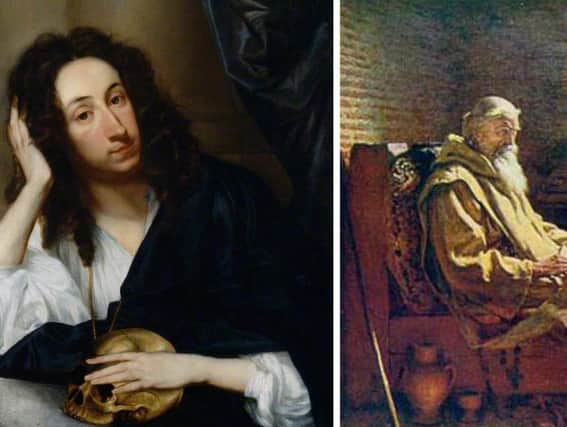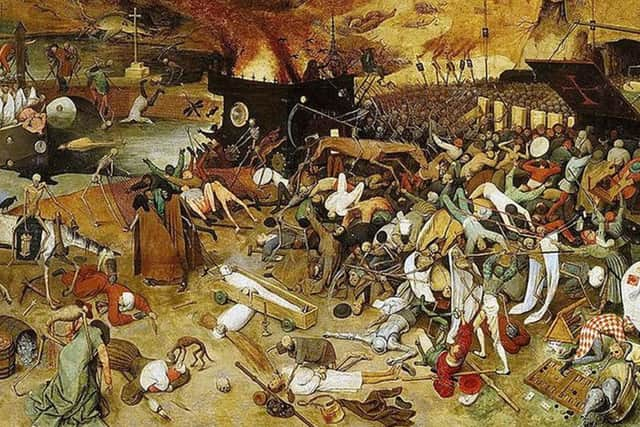Bede and diarist John Evelyn chronicled plague horror


To him we owe the first written account of plague in Sussex.
Bede relates how Oswald, King of Northumbria, converted to Christianity. Though he only lived until the age of 38 when he was killed in battle in 642, Oswald was bestowed saintly status after his death. Bede credits him with visiting one of St Wilfrid’s monasteries in Sussex to cure the local people of a virulent plague. Bede tells us that Oswald’s successful intervention led to him being widely feted in the south of England.
Advertisement
Hide AdAdvertisement
Hide AdThe monk obviously had a deeply religious nature and would have believed in miracles without question so we do need to take Bede’s account of Oswald’s medical efficacy with a pinch of salt. Sadly, next time plague came calling in Sussex there was no saint on hand to administer a dose of supernatural medicine.


Fast forward to the early 14th Century. Medieval man was easy prey to omens and portents but not necessarily without good cause. In 1345 there was a coming together of the planets Jupiter, Mars and Saturn. Then from the far side of the world came stories of a dreadful sickness that was mercilessly striking down uncounted thousands. We now know it was an outbreak of bubonic plague that ravaged China. By October 1347 the plague had reached Italy carried there by black rat stowaways on merchant ships. The rats hosted fleas and the fleas hosted the plague bacteria, “yersina pestis”.
Over the next five years, around one third of Europe’s population would die from the Black Death – so-called because a major symptom was the onset of ugly black pustules on the skin of victims. Britain did not escape. Indeed, it is very likely that Sussex was one of the first places to encounter the plague. Rye was a busy port engaged in commerce with the Continent and would have been a natural point of entry for fleas that could have easily hitched a lift in imported bales of cloth. There was also a clandestine industry that saw Romney Marsh wool smuggled to France and silk and spices carried on the return sailings, so here was another opportunity for the plague to spread with frightening rapidity. We have been left some sad “snapshots” illustrating how the tragedy unfolded. At Michelham Priory eight out of the 13 brothers died. At Battle Abbey half the monks including the Abbot perished and at Wartling near Pevensey, 70 villagers were struck down. In nearby Hooe surviving inhabitants simply fled. Indeed, many villages were similarly abandoned forever, one of these being Hamsey, north of Lewes.
Hamsey occupied an island in the Ouse valley and was a substantial Saxon settlement with access to the sea via the river. King Ethelstan (925 – 940) once held his court there in preference to Lewes. But after the devastating Black Death, those left alive moved to Offham at the foot of the Downs. Today Hamsey consists of a picturesque church, a farm and just a few houses. Peasmarsh, north west of Rye, was also affected. Historians surmise this because the village’s Norman church sits isolated in a lane around a mile away from the present-day habitation. Following such a traumatic experience of so much death at such close quarters, one can understand why those who were spared would want to make a fresh start in a place removed from the scene of such horror.
Advertisement
Hide AdAdvertisement
Hide AdThe Black Death abated in winter but would return with a deadly vengeance in the spring. The years 1348 to 1353 were the worst. After this time the outbreaks diminished maybe because those remaining had a natural immunity. Or perhaps people simply ceased mixing and mingling, sensing that isolation offered a hope of evading the sickness. When the plague at last all but disappeared there was a silver lining for the surviving peasantry. Wages in the countryside rose sharply because there was an acute shortage of labour. In effect, the Black Death hastened the end of the feudal system. In 1664 the plague returned. In the time since the Black Death, medicine had not advanced by much and again there was no known cure. Doctors bled their patients, washed their bodies in vinegar and experimented with concoctions of sage and angelica. Even dried frogs and arsenic were administered but all to no avail. The satirist Daniel Defoe was scornful of folk who daubed the word “abracadabra” on their homes hoping it was a magic talisman that would ward off evil. Others appealed to a higher deity, marking their house with a red cross and the imploring message “May the Lord have mercy upon us.”


London was worst hit. The eminent diarist John Evelyn (who had been schooled in Lewes and lived in the town’s Grange mansion as a boy) lived through it. We have his observations (sic) from 1665: “7th September. The contagion now growing all about us. Came home, there perishing now neere ten-thousand poore creatures weekely. However I went all along the Citty to St. James’s, a dismal passage & dangerous, to see so many coffins exposed in the streetes & the streete thin of people, the shops shut up, & all in mournefull silence, as not knowing whose turn might be next.”
Evelyn and all his family were unharmed. In 1666 they witnessed the Great Fire of London, a terrible conflagration but one that purged the capital of the last vestiges of the plague.